Heitjans P., Karger J. (Eds.). Diffusion in Condensed Matter: Methods, Materials, Models
Подождите немного. Документ загружается.


772 Klaus W. Kehr et al.
In all lattice-gas models the physical properties depend crucially on
whether a net bias in the hopping rates leads to a mean drift in the mo-
tion of the particles (and hence to a finite density-dependent current) or
not. The intrinsic non-equilibrium behavior of driven diffusive systems is
reviewed in detail in [18,61]. Besides the existence of novel and unusual non-
equilibrium phase transitions, the most remarkable features are the occur-
rence of shocks [62–64] and the importance of the physical boundaries of the
system [65–69]. In this section we consider only symmetric hopping models
where the rate of hopping does not depend on the direction of hopping across
the bond between the two sites.
18.4.2 Collective Diffusion
Consider the most basic site exclusion model where particles hop between
nearest neighbor sites with a constant rate Γ .Thismodelisknownasthe
simple symmetric exclusion process, introduced by Spitzer [70]. Many exact
results are known, see [18,71].
The basic quantity for the description of collective diffusion is P (l,t), the
probability that site l is occupied by a particle at time t.Theimportant
point is that the identity of the particles is disregarded in its definition. The
quantity P (l,t) has a different meaning than the conditional quantity P
l
(t)
in the single-particle case. It is a member of a set of probabilities, defined
on the lattice sites l which gives the mean occupation number and hence the
mean density on site l at time t .LetP (
¯
l,t) be the probability that site l is
empty. Obviously the following normalization condition holds:
P (l,t)+P (
¯
l,t)=1. (18.91)
The master equation for P (l,t) in the site-exclusion model is:
d
dt
P (l,t)=Γ
l
,l
[P (l
,
¯
l,t) − P (l,
¯
l
,t)] . (18.92)
Here P (l
,
¯
l,t) is the joint probability that site l
is occupied and site l is
empty at time t. The joint probabilities fulfil the relations
P (l
,
¯
l,t)+P (l
, l,t)=P (l
,t)
P (l,
¯
l
,t)+P (l, l
,t)=P (l,t) . (18.93)
Since P (l, l
,t)=P (l
, l,t) , insertion of (18.93) into (18.92) yields
d
dt
P (l,t)=Γ
l
,l
[P (l
,t) − P (l,t)] . (18.94)
This equation is identical to the master equation for the single-particle case.
The initial conditions, however, are different. The derivation presented above
18 Diffusion of Particles on Lattices 773
including that of the coherent dynamical structure function has been pro-
posed by Kutner [72].
As a consequence of the master equation (18.94), the coefficient of collec-
tive diffusion results to be
D
coll
= Γa
2
, (18.95)
which is identical to the diffusion coefficient of a single particle on a uniform
lattice (The numerical factor applies to hypercubic lattices in all dimensions).
The important feature of (18.95) is that the collective diffusion coefficient
does not depend on the concentration of the site-exclusion lattice gas.
The mathematical reason for the absence of the concentration dependence
in the symmetric exclusion process is an underlying SU(2) symmetry of the
generator of this Markov process. In the quantum Hamiltonian formalism
for the master equation the Markov generator turns out to be the SU(2)-
symmetric quantum Hamiltonian of the Heisenberg ferromagnet [73, 74]. In
this correspondence the (many-particle) dynamics of the local density P (l,t)
is related in a simple fashion to the (single-particle) spin-wave dynamics of
the ferromagnet. This accounts for the identity of the dynamical equation
(18.94) for the local density with the single-particle diffusion equation.
18.4.3 Tracer Diffusion for d>1
The diffusion coefficient of a tagged particle, D
t
, is defined from the asymp-
totic behaviour of its mean square displacement for t →∞
R
2
(t) → 2dD
t
t. (18.96)
In this chapter only a cursory treatment of tagged-particle diffusion in the
site-exclusion model for d>1 will be given.
Consider a tagged particle. Its mean transition rate is (1 − c)Γ ,where
1 − c is the blocking factor, i. e. the probability of finding an unoccupied
site in the site-exclusion model. A mean field estimate of the tagged-particle
diffusion coefficient is
D
MF
t
=(1−c)Γa
2
, (18.97)
hence D
t
is smaller than D
coll
. Bardeen and Herring [75] pointed out that
(in the limit c → 1) there exists a backward correlation in the random walk
of a tagged atom. To understand its origin, regard Fig. 18.13, where a tagged
particle has made an exchange with an empty site.
Immediately after the transition there is an increased probability for a
backward transition of the tagged particle, due to the presence of a vacancy,
with certainty, at the initial particle position. This can be accounted for by
introducing a correlation factor f(c), with generally f (c) ≤ 1,
D
t
=(1− c)Γa
2
f(c) . (18.98)
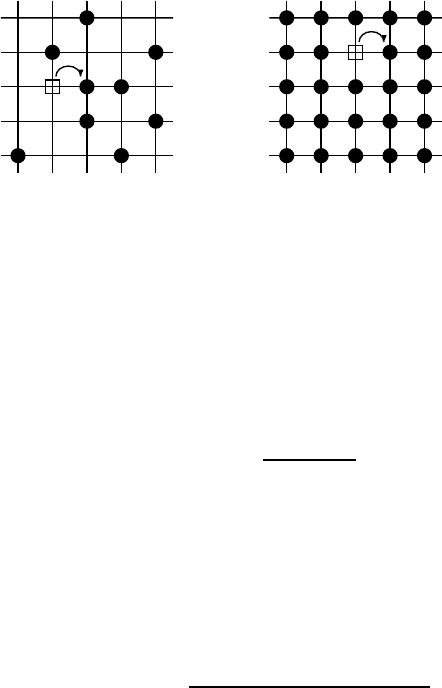
774 Klaus W. Kehr et al.
(b) c -> 1(a) c < 1
Fig. 18.13. Illustration of origin of backward correlation; (a) lattice gas of arbitrary
concentration; (b) limit relevant to metal physics.
In metal physics the factor 1−c is the concentration c
V
of thermally activated
vacancies and c
V
1. The correlation factor f = f(c → 1) can be calculated
from the random walk of a single vacancy. Its walk is uncorrelated and can be
described by the methods of Sect. 18.2.1. The tagged atom, however, performs
correlated random walk. In the limit c → 1 only consecutive jumps of the
tagged particle are correlated. Then [76]
f =
1+cos ϑ
1 −cos ϑ
, (18.99)
where cos ϑ is the average angle between two consecutive transitions of the
tagged particle. This quantity can be calculated exactly from the random
walk of a single vacancy [77]. Values of cos ϑ and f for various lattices are
given in [78]. An example is the value f =0.727 ... for the bcc lattice.
Extensions to arbitrary concentrations of the lattice gas were made by
Nakazato and Kitahara [79] and Tahir-Kheli and Elliott [80]. They derived
f =
1+cos ϑ
1+[(2− 3c)/(2 − c)]cos ϑ
, (18.100)
where cos ϑ has the same meaning as above. Equation (18.100) is an ap-
proximate expression, but simulations show that the deviations are less than
1-2 % of the correct value (see Fig. 18.14). Of course, f (c = 0) = 1, and
f(c → 1) reproduces (18.99). More details about the correlation factor, in
particular about its relevance for experimental studies, have been presented
in Chap. 1.
18.4.4 Tagged-Particle Diffusion on a Linear Chain
Tagged-particle diffusion on a linear chain is completely different from tagged-
particle diffusion in higher dimensions (d ≥ 2). The reason is that the
tagged particle cannot pass the other particles, as schematically illustrated
by Fig. 18.15.
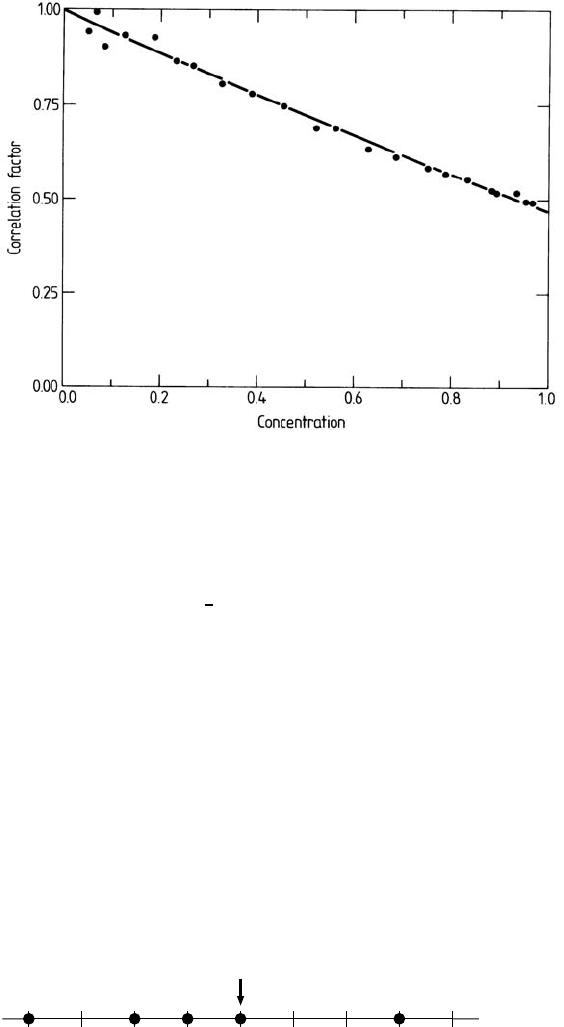
18 Diffusion of Particles on Lattices 775
Fig. 18.14. Correlation factor for site-exclusion lattice gas on a square lattice as
a function of concentration. Line: (18.100); symbols: MC simulations. From [81].
As a consequence, the mean square displacement of the tagged particle,
δx
2
(t), is no longer proportional to t. It turns out that the mean square
displacement of a tracer particle under the single-file constraint is asymptot-
ically proportional to
√
t. This phenomenon is called single-file diffusion and
it was first described in the physical literature by Richards [82]. There exist
formal derivations of this behaviour (see [83] and references therein). How-
ever, the analytical derivations are rather difficult. Therefore, a derivation
of the asymptotic behaviour from a physical consideration will be presented
that is due to Alexander and Pincus [84]. The main idea is that the rela-
tive displacements of two tagged particles are caused by density fluctuations
of the other particles. These density fluctuations are governed by collective
diffusion.
For the derivation a continuum description will be adopted. In Fig. 18.16
the equilibrium positions and the displacements of two tagged particles are
indicated.
A relation between the displacement difference and the change of density
δn(x, t) in between the two particles is required. This relation is derived in
Fig. 18.15. Tagged-particle diffusion on a linear chain.

776 Klaus W. Kehr et al.
x
δ
u(x)
u(x+ x)
x+ x
δ
Fig. 18.16. Coordinates for the derivation of the mean square displacement in
single-file diffusion, following [84].
the appendix (Sect. 18.7.3) and it reads in Fourier space
1
n
δn(k, t)=iku(k,t) , (18.101)
where u(k,t) is the Fourier transform of the displacement u(x, t) of the tagged
particle. It follows
u(x, t) − u(x, 0) =
1
n
dk
2π
e
ikx
1
ik
[δn(k, t) − δn(k,0)] . (18.102)
The square of this expression will be taken. One is interested in the random-
walk average of the square. Instead of performing this average, one can take
the ensemble average over many tagged particles, with the result
[u(x, t) − u(x, 0)]
2
=
1
N
dx[u(x, t) − u(x, 0)]
2
=
1
Nn
2
dk
2π
2
k
2
[δn(k, 0)δn(−k, 0)
−δn(k, t)δn(−k, 0)] . (18.103)
Here the density fluctuations are averaged over the stochastic dynamics
of the lattice gas. The decay of density fluctuations is governed by collective
diffusion; in the limit of long wavelengths k → 0, i.e., for long times, one has
δn(k, t)δn(−k, 0)−→Nc(1 − c)exp(−D
coll
k
2
t) . (18.104)
Insertion of this relation into (18.103) and transcription of the right-hand
side into a lattice formulation gives (a =1)
[u(t) − u(0)]
2
=
2(1 − c)
c
∞
−∞
dk
2π
1 − exp(−Dk
2
t)
k
2
. (18.105)
The integral is
∞
0
dx
1 − e
−λ
2
x
2
x
2
= λ
√
π. (18.106)
Hence one obtains using the result (18.95) for D
coll

18 Diffusion of Particles on Lattices 777
Fig. 18.17. Mean square displacement of tagged particles on a linear chain at
concentration c ≈ 0.5 as a function of time. Lines: theory; symbols: MC simulations.
From [83].
[u(t) − u(0)]
2
=
2(1 − c)
c
&
Γt
π
. (18.107)
This is the characteristic behaviour of the mean square displacement of tagged
particles under the single-file constraint. Experimental evidence for single-file
diffusion is reported in Chap. 10.
Expression (18.107) is valid for long times. For short times (1 −c)Γt 1
one has
δx
2
(t)=2(1− c)Γa
2
t. (18.108)
In this time regime one recovers the mean-field result (18.97) for the tracer
diffusion coefficient. In [83], an approximate expression was derived that cov-
ers the complete time region. Figure 18.17 shows numerical simulation results
for the mean square displacement of tagged particles, together with the the-
oretical curve of [83]. One recognizes the proportionality of δx
2
(t)with
√
t
for longer times.
It is instructive to consider two coupled lines between which the particles
can make transitions with rate Γ
⊥
, under the condition that the target sites
on the other chain are not occupied, cf. Fig. 18.18. The single-file constraint
is now relieved and one expects that a tagged particle makes asymptotically
normal diffusion,
δx
2
(t)=2D
t
t. (18.109)
A heuristic derivation of the diffusion coefficient D
t
in this situation can
be given by putting together single-file mean square displacements of the
particle according to (18.107) at time intervals 1/Γ
⊥
(1 − c), see Fig. 18.19.
This is the mean time, where a tagged particle makes a transition to
the other chain and starts a new displacement. The slope of the dashed line
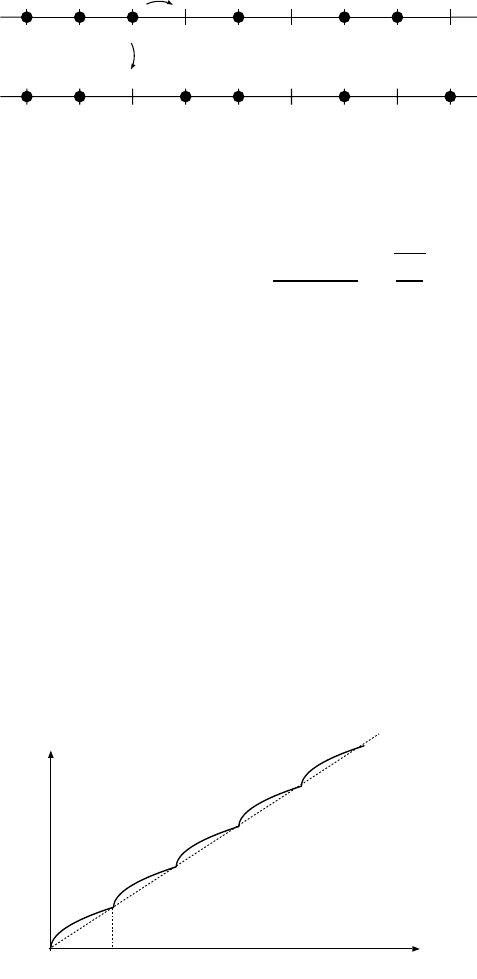
778 Klaus W. Kehr et al.
Γ
Γ
⊥
Fig. 18.18. Particle diffusion on two coupled lines.
in Fig. 18.19 can be determined in the following way: Take δx
2
at time
t =1/Γ
⊥
(1 − c) and divide by this time. This gives as an estimate for the
diffusion coefficient
D
t
∼
=
(1 − c)
3/2
c
Γ
&
Γ
⊥
Γ
. (18.110)
An approximate theory which is valid at all times, was given in [85].
Figure 18.20 presents the results of numerical simulations together with the
theoretical results of this paper. One recognizes how the asymptotic behav-
iour ∼ t is reached for Γ
⊥
/Γ = 0 after a crossover region.
18.5 Many Particles on Disordered Lattices
18.5.1 Models with Symmetric Rates
In this final section of this chapter, diffusion of many particles on regular lat-
tices with disordered transition rates will be treated. The disordered rates are
assumed to be fixed, i. e. quenched disorder is assumed. The considerations
will be restricted to the site exclusion model, where double occupancy of the
sites is forbidden, and no further interactions of the particles are present.
Only the coefficient of collective diffusion will be studied. Even with all
<x >
2
t
[(1-c) ]
-1
Γ
⊥
Fig. 18.19. Heuristic derivation of the diffusion coefficient of a tagged particle on
two coupled lines.
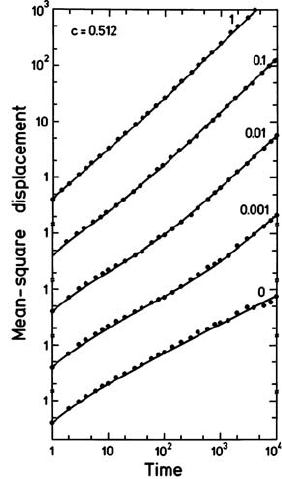
18 Diffusion of Particles on Lattices 779
Fig. 18.20. Mean square displacement
of tagged particles on two coupled lines
as a function of time. Lines: theory; sym-
bols: MC simulations. The ratio Γ
⊥
/Γ is
indicated on the curves. From [85].
these restrictions, the problem is very difficult, with one important excep-
tion. Namely, for symmetric transition rates, the problem can be reduced to
the independent-particle problem. This case will be treated in this section.
The cancelation of the joint probabilities in the master equation for P (l,t)
that has been shown in Sect. 18.4.2 for lattices with uniform transition rates
is also valid for disordered lattices as long as Γ
ij
= Γ
ji
. In this case the
hierarchy of many-particle equations reduces to the single-particle equation
with disordered, symmetric rates. Consequently [86]
if Γ
ij
= Γ
ji
then D
coll
= D
s.p.
. (18.111)
The index s.p. means single, independent particles. The origin of this cancel-
lation is the symmetry under the Lie algebra for the special unitary group
SU(2) of the generator of the process which holds on any type of lattice with
arbitrary bond-symmetric disorder [74]. Also symmetric processes with par-
tial exclusion of up to M
i
particles on lattice site i have this property [18]. A
result equivalent to (18.111) was obtained for the conductivity by Harder et
al. [87].
The models of interest are the random barrier model and the model with
randomly blocked sites.

780 Klaus W. Kehr et al.
18.5.2 Selected Results for the Coefficient of Collective Diffusion
in the Random Site-Energy Model
The nontrivial case for collective diffusion of site-exclusion lattice gases in
disordered lattices is the case of site-energy disorder. No cancelation of the
joint probabilities P (l, l
,t) occurs in the master equation and one has to
resort to approximations, with two exceptions. The first exception is the site-
exclusion lattice gas on a linear chain with random site energies (RT model)
in the limit of very small vacancy concentrations, c
V
→ 0. The diffusion
problem of single vacancies can then be solved, for instance by the methods
of Sect. 18.3.2, and the exact result for the corresponding diffusion coefficient
D
s.v.
was given in [88]. In the limit c → 1 D
s.v.
agrees with D
coll
. Second, an
exact expression for the collective diffusion coefficient can be given for the
RT model in the limit of infinite dimensions. Apart from these two cases, no
further exact results for the collective diffusion coefficient are known. Hence
approximate treatments are necessary.
An effective medium approximation for collective diffusion of site-exclusion
lattice gases can be formulated in the following way. First the problem has to
be reduced to an effective one-particle problem. This can be achieved by an
obvious extension of the results for the single-particle case, where weighted
transition rates were used. The following effective or mean field single-particle
transition rates will be introduced
Γ
Sym
ji
=
P
i
(1 − P
j
)Γ
ji
{P
i
(1 − P
i
)}
. (18.112)
The quantity P
i
is the thermal equilibrium occupation of site i.Itisnor-
malized differently from ρ
i
, hence a normalization factor in the denominator
of Γ
Sym
is required. The symmetry of the rates Γ
Sym
follows from detailed
balance. The rate equations (18.112) were already introduced in [89] in the
context of lattice-gas diffusion on linear chains.
The second step is the use of Γ
Sym
in an effective-medium approximation.
Since the rate equations (18.112) are symmetric, the formulation of the EMA
of Sect. 18.3.5 can be used. From the EMA the limit of infinite dimensions
(infinite coordination number) is easily obtained [90]. The result is
D
phen
coll
= {Γ
Sym
ji
} =
P
i
(1 − P
j
)Γ
ji
{P
i
(1 − P
i
)}
(18.113)
and it represents a phenomenological expression for the collective diffusion
coefficient that was derived in the context of metal physics [91] and surface
physics [92]. It is not surprising that a phenomenological theory is obtained
in the limit of infinite coordination number. The main problem in treating
collective diffusion of lattice gases in disordered lattices are the correlations
that are caused by particles which occupy sites with low energies and act as
blocking sites. The effects of these correlations become irrelevant in the limit
of infinite coordination number.
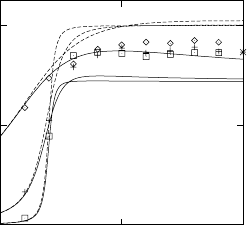
18 Diffusion of Particles on Lattices 781
0
0.4
0.8
0 0.5 1
D
coll
c
Fig. 18.21. Collective diffusion coefficient of site-exclusion lattice gas in a two-
level RT model in d = 3, as a function of concentration. 20 % of the sites are trap
sites. Continuous lines: EMA; dashed lines: phenomenological theory; symbols: MC
results for Γ
<
/Γ =0.1(), 0.01 (+) and 0.001 (2). Limiting value c → 1: ∗.
Fig. 18.21 shows results for a two-level RT model in d = 3 which consists
of free sites with concentration 1 − c
t
and transition rates Γ , and trap sites
with concentration c
t
and rates Γ
<
. The results of numerical simulations are
compared with the EMA and the phenomenological expression (18.113).
The main feature of the results is that D
coll
is determined by the satura-
tion of deep trap sites by particles. This was first pointed out by Kirchheim
who modelled hydrogen diffusion in metglasses [93]. The saturation effect is
a rather general feature of collective diffusion in systems with site-energy
disorder and is not restricted to a particular realization of the disorder.
The figure also shows that the single-particle result is approached for
c → 0. Also the limit c → 1andΓ
<
/Γ 1 can be understood for the two-
level RT model. In this limit D
coll
is given by the single-particle result for
the RBS model. Namely, the deep trap sites are saturated by particles and
act as blocking sites. It was discussed in Sect. 18.5.1 that for the RBS model
D
coll
≡ D
s.p.
. Additional EMA and numerical results are given in [90].
It has been shown in Sect. 18.3.6 that the diffusion coefficient of single, in-
dependent particles vanishes in the RT model for an exponential distribution
of site energies, at low temperatures. The relevant parameter is α = k
B
T/E
c
,
where E
c
characterizes the width of the distribution. The result was D
s.p.
≡ 0
for α<1 (cf. (18.81)).
What happens when a finite concentration of particles is filled into the
lattice? The particles tend to occupy the sites with low site-energies, satu-
rating thereby the low-lying levels. If now a density disturbance is set up in
the lattice gas, the disturbance should decay by collective diffusion. This was
indeed observed in the numerical simulations of [94], and D
coll
was obtained
by monitoring the decay of cosine density profiles.
